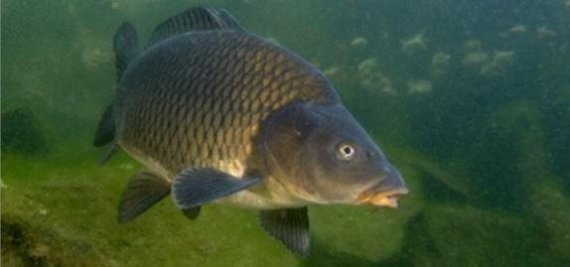<carp; photo: Flickr>
When a carp is infected with the koi herpes virus, it is often as good as dead. However, if the carp swims to a warmer spot, it suppresses the multiplication of the virus and may thus survive. The increase in temperature can be compared with the fever humans get when infected. As the carp is an ectotherm (‘cold blooded’) animal, it cannot control its own body temperature. It must therefore swim to warm water in order to increase its body temperature. Biologists call this phenomenon ‘behavioural fever’.
Cytokine
Together with veterinary researchers from Liège, Maria Forlenza and Geert Wiegertjes of Cell Biology and Immunology have now found the mechanism behind this behavioural fever in carps. The immune system of the fish produces a signalling substance, a cytokine with the abbreviation TNF-α, which ensures that carps swim toward warmer water. It is not entirely coincidental that this cytokine also generates fever in humans during a virus infection.
But the koi herpes virus does not give up this easily, discovered the researchers. This virus contains a gene that codes for a receptor that catches this cytokine. This TNF-receptor thus suppresses the behavioural fever and prevents the fish from swimming toward health. The researchers have published their results in the February issue of Cell Host & Microbe.
Mechanism
It was already known that fish generate a fever by swimming toward warm water. Neither is it new that viri can influence the behaviour of their host. The new aspect is that the researchers from Liège and Wageningen found the mechanisms behind this behaviour for both the carp and the virus.
They managed to clearly demonstrate the functioning of the cytokine in the carp and the TNF-receptor in the virus in an aquarium with three different temperature compartments. When the carps were injected with the TNF-α cytokine, they would swim toward the warmer spots. When the carps were infected with the herpesvirus, they did not. However, when the researchers blocked the TNF-receptor in the virus, the carps did swim toward the warm water.
Vaccine
Will we be able to better protect carps with this knowledge? It might be possible to use a herpesvirus without TNF-receptor as a vaccine in fish farming, says Forlenza. Such a weakened herpesvirus could sufficiently activate the immune system of the carp without killing it. But Forlenza does not want to create high expectations. ‘The koi herpes virus is a very complex virus with a diverse arsenal. It is an "intelligent" virus. I think we would have to block multiple molecules simultaneously to sufficiently weaken the virus.’
Forlenza is well acquainted with the herpesvirus; she had already discovered that this virus also has a gene that codes for the IL-10 molecule. This is a different cytokine that the virus once ‘kidnapped’ from the carp and which it now exploits to suppress the carp’s immune system. A herpesvirus without both TNF-receptors and IL-10 might be sufficiently weakened to act as a vaccine.

